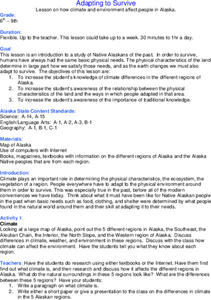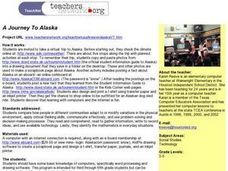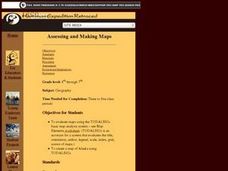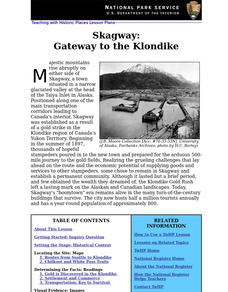Curated OER
Adapting to Survive
Young scholars examine how the climate and environment affect people in Alaska. They identify the five regions of Alaska on a map, conduct Internet research, write a report on the climate differences in the five Alaskan regions, and...
Curated OER
A Constitution for Alaska
Students read sections cited from the Governing Alaska unit. They discuss factors that made Alaskans push for statehood. They view video A Constitution for Alaska.
Curated OER
A Journey To Alaska
Students create an electronic scrapbook of a virtual field trip to Alaska. They first check the weather and plan what to bring for a real trip. As they explore various websites representing five stopovers on the trip they copy photos...
Curated OER
Alaska's Cultures: The View from Inside: Traditional Cultural Literature
Learners read and discuss Alaskan Native stories and legends. They share summaries and questions from the reading.
Disney
Where Do Brown Bears Live?
What do brown bears in Alaska's Katmai National Park need to survive? Pupils explore the unique habitats, diet, and survival needs of this animal. They predict the consequences of removing any integral part of the bear's survival,...
Curated OER
Alaska's Native Population: Eskimos, Indians and Aleuts
Learners explore the unique population of Alaska. In this Native people of Alaska lesson, students discover the three groups of people who live in Alaska. Learners describe the similiarities and differences between the three groups....
Curated OER
We Were Here First
Students explore the legal and historical experience of native peoples living in the United States. They write a letter to their United States senator commenting on the Hawaiian bill using information gathered during their research.
Curated OER
Can We Be Both Conservationists and Consumers?
Students explore their role as consumers and conservationists and what roles they play in today's economic climate. They explore resource allocation issues. Students analyze data and draw comparisons between historical and present-day...
Curated OER
How Has Transportation Changed Since the 1899 Harriman Alaska Expedition?
Students recognize modes of transportation. They research historical data from a variety of primary and secondary sources including the Harriman expedition journals, related web sites, and photographs from the expedition. Students...
Curated OER
What Do We Learn From the Repartiation of Alaska Native Artifacts?
Students observe and evaluate evidence of Alaska Native cultural symbols and artifacts. They research historical data from a variety of primary resources, including the Harriman expedition journals, related web sites, oral accounts,...
Curated OER
Learning About Location: Charting the Path of the George W. Elder
Students acquire a working knowledge of the geographical concepts: absolute location, relative location, longitude and latitude. They analyze primary sources that shows the physical and human characteristics of the places along the 1899...
Curated OER
Assessing and Making Maps
Students evaluate maps using the TODALSIGs basic map analysis system, explained on the worksheet. They create a map of Alaska using TODALSIGs. Students brainstorm the elements of maps.
Curated OER
Energy Alternatives and Conservation
In this energy alternatives and conservation learning exercise, students research the topic, answer 3 questions, then complete a 4 step plan to create a print or digital project. This page has numerous links to web resources.
Curated OER
Skagway: Gateway to the Klondike
Students explore the impact of the Klondike Gold Rush on the development of Skagway, Alaska. Lesson can be used in units on western expansion, late 19th and early 20th-century commerce, and urban history.
Curated OER
"Julie of the Wolves"
Fifth graders research life in Alaska and compare life there to their lives in this lesson. They read "Julie of the Wolves." They research through the novel and other reference books facts about the Alaskan climate and geography. They...
Curated OER
Observing Sea Ice
Students study and observe types of sea ice found in Alaska. In this sea ice lesson, students use the student network for observing weather to study the different types of sea ice. Students study sea ice depicted in Alaskan art.
Curated OER
It Bears Repeating!!!
Students research bears and their characteristics with a specific study on North American bears and polar bears. In this bear study lesson, students read books about polar bears and wild bears. Students complete activities to further...
Curated OER
The Beaufort Scale: A Local Model
Students study the Beaufort Scale and use it to study wind in their community. In this wind study lesson, students watch a DVD about climate change and learn about the Beaufort Scale. Students complete a worksheet for the topic.
Curated OER
Gray Whales on the Move
Middle schoolers study whale migration and their natural history. In this migration activity students plot whale migration on a map and describe their ecosystems.
Curated OER
Slick Moves
Students examine the Bush Administration's plan to drill for oil in the Arctic National Wildlife Refuge from varying points of view.
Curated OER
Russia's Colony: Examining the Effects of Russian Colonization
Students respond to the question: How did Russian colonization effect Alaska's history? students examine environmental, cultural, economic, social and political impacts.
Curated OER
There's a Place That Has a Race
Pupils define the term "place," collect data about Alaska and the Iditarod from several web sites, take online quiz using information gathered, and draw conclusions based upon their data collection and analysis.
Curated OER
Hawaii's Future Tied to History
Students investigate Hawaii's history to help them explain how a Reorganization Act may affect its residents. students track the region's history from statehood, to kingdom, to human settlement.
Curated OER
Alaska's Current Issues
Students work in small groups to brainstorm a list of issues in Alaska. As a class, they discuss their concerns. Students place their issues in two lists, those that are in the domain of the local and state governments, and those that...























